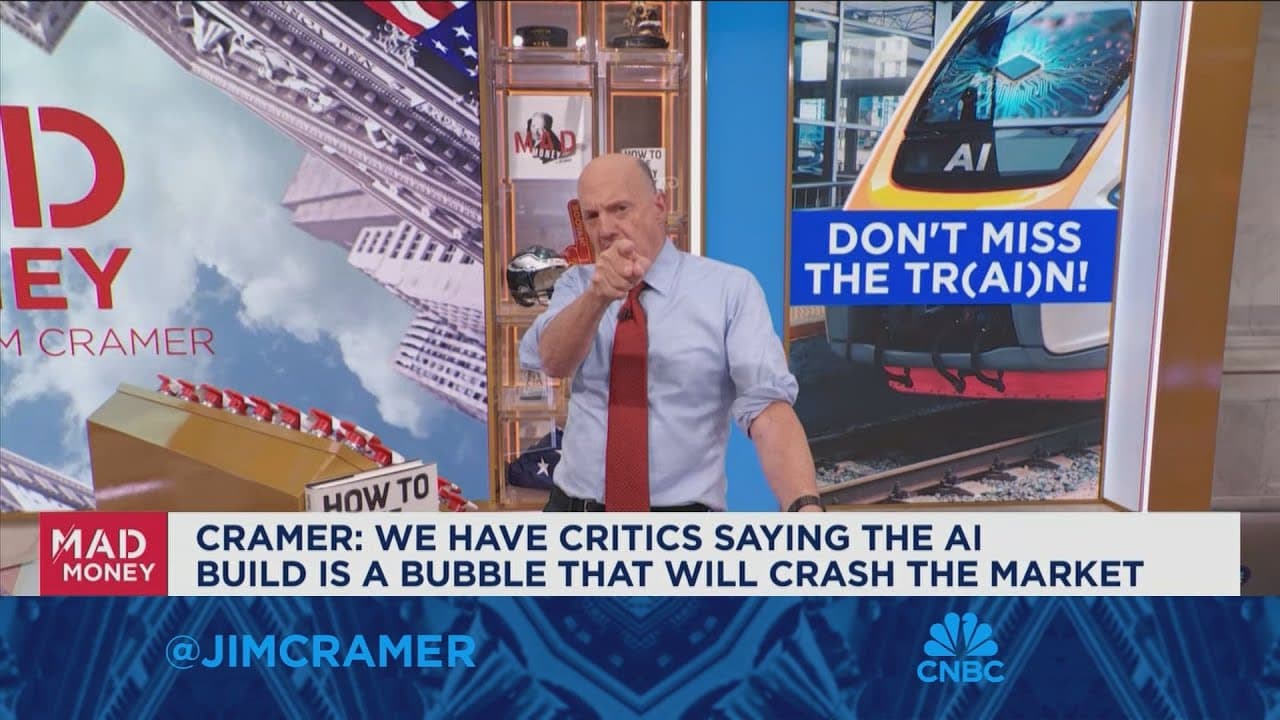加载中...
共找到 3,354 条相关资讯

We're in the waning days of the third quarter – and that means the year-end sprint is about to begin. The MoneyShow Chart of the Day shows the performance of the 11 S&P 500 sector SPDR funds from the start of the quarter through Sept.

The bottom line is that aggregate corporate margins remain at high levels, and consumers have been largely shielded from rising prices.

A week dominated by central bank communications and seasonal dynamics kept investors on edge, even as the UN General Assembly passed without major geopolitical surprises except for some memorable US President Trump quotes. Resilient job numbers, as seen in the latest Jobless Claims report, and decent macro conditions for now helped the greenback regain ground, underscoring the relative strength of the US economy against global peers.

Panelists Steve Moore and Kevin Brady break down U.S. economic data and the impact of President Donald Trump's policies on 'Kudlow.'#stevemoore #kevinbrady #kudlow #foxbusiness #trumpeconomy #federalreserve #useconomy #economicgrowth #trumppolicies #economics

CNBC's Jim Cramer discusses the day's market action, the possibility of a market bubble in AI stocks and more.

CNBC's Jim Cramer discusses the day's market action, the possibility of a market bubble in AI stocks and more.

PCE inflation comes in as expected

CNBC's “Fast Money” team discusses new inflation data, the likelihood of the Federal Reserve's interest rate cuts and what may be next for the U.S. economy with Peter Boockvar, chief investment officer at One Point BFG Wealth Partners.

This week, we revisit two stories we brought you over the past year and discuss what has changed since then. How has trade between the US and Mexico shifted since President Donald Trump took office, and where do Canadian auto parts fit into the trade spat between the North American countries?

CNBC's “Fast Money” team discusses the potential impact of pharmaceutical tariffs with Jared Holz, healthcare equity strategist at Mizuho.

Data center CAPEX projected to surpass $1.2T by 2029, fueled by hyperscaler AI infrastructure buildouts. Top six tech firms hold $2T spending power in my opinion, combining borrowing capacity and cash equivalents, enabling massive future investments.

Consumer sentiment has always been more than a mood measure. It shapes how households decide whether to spend, save or delay purchases, and even how they think about the security of their jobs.

CNBC's “Closing Bell Overtime” team discusses what to watch next week with Adam Crisafulli of Vital Knowledge.

Comprehensive cross-platform coverage of the U.S. market close on Bloomberg Television, Bloomberg Radio, and YouTube with Romaine Bostick, Vonnie Quinn, Carol Massar and Tim Stenovec. -------- More on Bloomberg Television and Markets Like this video?

The Dow and other indexes rise in Friday's stock market after inflation came in line with estimates.

The risk that pressure from U.S. President Donald Trump could shift the Federal Reserve to an overly dovish stance is the main near-term concern for the U.S. dollar, said a senior executive at U.S. asset manager PGIM Fixed Income.

The latest economic reports show that spending growth is outpacing income gains. That trend won't last forever.

“Be careful.” That's one Wall Street pro's advice as AI spurs a wave of debt offerings and consumer backlash.
Operator: Good afternoon, and welcome to the Polarean Imaging plc Investor Presentation. [Operator Instructions] Before we begin, I'd like to submit the following poll. I'd now like to hand you over to Christopher Von Jako, CEO. Good afternoon, sir. Christopher Von Jako: Thank you so much. I appreciate it. So hello. As mentioned, my name is Chris Von Jako. I'm the CEO of Polarean, and I'm joined today by our CFO, Chuck Osborne. So thank you for taking the time to be with us. I'll begin with an overview and some additional context on the RNS we released this morning. And after that, I'll walk through an updated presentation, both as a refresher for those familiar with Polarean and as an introduction for any new to the story. Finally, Chuck and I will take a number of questions at the end of the presentation. So before I begin, just as a reminder, these are the normal disclaimers. We are revolutionizing pulmonary medicine with our FDA-approved Xenon MRI platform. It is the only noninvasive radiation-free technology that shows the full picture of lung function. So usage is growing across our leading academic centers, both in clinical as well as research. And as you may know, our technology is available for use on all 3 major MRI vendors. So that includes Philips, GE and Siemens. Reimbursement is active, which is great for us, and clinical sites are billing and getting paid for Xenon MRI exams. In March, we announced a third revenue vertical in our pharma trial, which is in pharma trials, where we also signed our first multicenter trial, and we continue to build a growing pipeline with our partner, VIDA. And then lastly, on this slide, our platform is really backed by nearly about 1,000 publications and growing in more than about 200 clinical studies, providing strong scientific and clinical validation. So there's no question our first half revenue has been disappointing to both the market and our team. We did not close any new systems in the first half. Obviously, this morning, we announced a new order from the NIH, which was quite significant. But consumable usage continues to grow, which shows strong engagement from our customers already using the platform. At the same time, we faced real market headwinds, right? So the NIH funding cuts have reduced resources available to many of our academic customers, while new Medicaid reductions just put in recently in July are putting an additional pressure on hospital budgets. Together, these policy shifts have slowed capital purchases, particularly for new innovative technology like ours, and it's really lengthened the adoption cycles. We expect this uncertainty to continue into 2026 as academic centers reassess and reset their budgets. That said, we're, I think, doing a great job of managing our cash with discipline and are funded to operate through the second quarter of 2026. And importantly, I would say commercial momentum is building. Physicians see the value today in our technology. Gas exchange approval would be transformative in the future for us. And administrators today value both our existing reimbursement and new revenue opportunities that, that reimbursement brings. So with Alan Huang, who joined us a year ago, actually, leading sales, quotes are sharply up. I think we're over $21 million, which is about a 650% increase from year-over-year. And those quotes get to a point when we release those quotes are -- when we're kind of in that process with these centers. So that's really good to see. Our total addressable market continues to expand across our focus fronts. So in June, we announced our expanded pediatric approval, which basically broadened access to over 1 million more potential patients with our technology with a controlled market release that we have planned actually next month and then hopefully, our first patient in Cincinnati Children's shortly after that. So based on our long ongoing discussions that we've had with the FDA, we redesigned our pivotal Phase III trial for gas exchange, which we announced that cut the cost in half to about $4 million to $4.5 million, and we expect to finalize the gas exchange trial plans before the year-end. Internationally, we continue advancing our potential for our OUS expansion through dealer partnerships. We've had some nice progress with Taiwan and also elsewhere in the Asia Pacific. With Philips, we are advancing approval of our XENOVIEW Chest Coil on their 3T MRI systems. While the coil is already FDA cleared, this additional Philips process ensures seamless integration within their installed base, which is great. And what that really means in practical sense is that the coil is fully compatible for clinical use across their 3 Tesla machines. It's integrated into the software. It'd be recognized automatically and managed safely during the scanning process. In March, as I mentioned, we announced our first pharma collaboration and basically, the Xenon MRI platform is being included in a substudy of a global multicenter trial for investigation of a new lung therapy. That trial is set to begin early next year. And as I mentioned earlier, obviously, our pharma pipeline continues to grow. And that first one that we announced really helps from a foundational standpoint. And finally, scientific momentum remains strong at this past year's American Thoracic Society Annual Meeting, which was held, I believe, in May. That is the leading global conference for pulmonary medicine. There were more than 30 Xenon MRI presentations across a range of indications. What was great is our Founder and Chief Scientific Officer, Professor Bastiaan Driehuys, was honored with a really special award there recognizing his pioneering work of bringing Xenon MRI from the benchtop to the patient. Also the International Society for Magnetic Resonance in Medicine, that's the premier global annual MRI conference that happens, that was in May as well. So Xenon was prominently featured there, including 2 presentations that I personally delivered, which was great. So it really is bringing up the overall presence and knowledge of the technology. And then obviously, we've had a number of really great new publications that validate the platform, including important new studies in lung cancer. I kind of touched on those in my presentation, both from a surgical planning perspective as well as in guiding radiation therapy for lung cancer. And I think that really underscores the growing recognition of Xenon MRI's clinical values, particularly in those areas with cancer. For 2025, given the headwinds that proved greater than we anticipated, we did announce that we're revising our revenue guidance down to $2.5 million to $3.5 million, which is down from our prior $5 million to $6 million. This obviously follows a very strong 2024, where we exceeded our guidance, but we continue to build a really good pipeline. That said, our backlog remains healthy. Prior to our announcement this morning with the NIH, which increased it significantly, it was at $1.2 million that was on orders that we had or stuff that we had delivered since June 30. So looking ahead, we expect to return next year or the following year to the $5 million to $6 million revenue trajectory as we expect market conditions to improve as hospitals continue to adjust with the news that they've had over the last several months, which really I think if I look at it in any way, it was just the uncertainty that has been there. That uncertainty is kind of coming away now, and they can now reassess on that. Importantly, from a profitability standpoint, we continue to see a clear path following the gas exchange approval, and we expect we can achieve that with about $20 million in incremental investment. Throughout, we continue to remain focused on executing our 5-pillar strategy. And as it says here, right, obviously, driving utilization, which we continue to do at both our clinical sites as well as our research sites. We want to grow our customer base. We want to strengthen our reimbursement, expand our total addressable market and continue to advance our partnerships that we have. So turning to the regular presentation. Our mission is to revolutionize pulmonary medicine. We talk about that, obviously, with this vision to optimize lung health and prevent avoidable loss by illuminating hidden disease. Our employees are united by this purpose, and our focus is always on the patients, delivering truly, I would say, breathtaking images that help clinicians detect disease earlier, guide treatment decisions and monitor outcomes over time. So lung cancer is the #1 cancer killer worldwide and over 500 million people suffer from chronic lung disease, yet we still rely on outdated tools. You can see here, if you want to look from an imaging perspective, you have X-ray and CT. They use radiation and only show anatomical structure. And then on the far right there, you can see me doing spirometry. That is obviously the standard for lung function today, but has its major limits. It gives no images and provides a very variable, nonpersonalized and insensitive measure. The lungs have 2 jobs. The first thing that they do is they ventilate. You can see that on the left-hand side, that was move air in and out. The second thing they do is oxygen crosses a thin membrane, a very thin membrane into the blood and the carbon dioxide moves out and is exhaled out of the body. But that deep region that's there is the silent zone. It's hidden from current test, yet it's where many diseases begin. And if you miss the silent zone, you miss that disease until it's too late. I tend to do this with investors just to think about structure and function and what the differences are. If you think about structure, it's like a road map. Here in San Francisco with the roads and the bridges, but there's no traffic. So if you add the traffic in, this is function. It shows what's moving freely and where the traffic jams are. CT works in the very same way. It shows the big structures, the major airways, but it can't see the silent zone where function matters most. And there -- if there's a traffic jam there, oxygen never reaches its destination. So how do we see the silent zone? Well, that's where Xenon MRI comes in. For the first time, we can apply the power and safety of MRI directly to the lungs. What you see is our ventilation scan is FDA approved, it's reimbursed, say, for patients now as young as 6. It occurs in a single 10-second breathhold. This is true 3D view of lung function. The Xenon gas acts as a safe surrogate for oxygen showing exactly where the lungs are working. What you can see here up in that left-hand side is where it's not working. So there's a blockage in the silent zone there, which is visible to other tools. And the gas clears completely from the body in seconds, making Xenon MRI safe, reliable and practical. So here's sort of a standard setup for Xenon MRI. If you look at the far left, the lungs are mostly filled with air. So you only see the outer boundary. So we take that first 10-second image of what we call a proton image or a structural image there. And in that second image, we add Xenon. So now you could see the function or where the ventilation is happening. But then you overlay the 2 together in that third image and you could see where the lungs work and where they're not. And that last image there is our software that really generates the quantitative maps turning the guesswork into clear insight. So this is the silent zone. This is where gas exchange happens. Oxygen, as I mentioned, crosses that thin membrane. It's actually 1 micron, which is invisible to the eye. And when it crosses that membrane, it goes into the red blood cells. But Xenon, as I mentioned, follows the same path. The breakthrough is that it resonates at a different frequency, whether it's in the air space, the membrane or the blood, letting us image all 3 compartments in that 10 seconds. But as we know, the bottom 2 there, I'm showing now a healthy patient, and you're seeing the healthy patient in the airspace, the membrane and the red blood cells. And we have our FDA approval for that top, which is looking at the airspace itself or what we call ventilation. So in a healthy subject, the flow is smooth. Everything is green. In like an airway disease like COPD or asthma, the traffic jam is in the airways. So air flow is blocked, which is shown there in the top image in the red and yellow. In a patient that has tissue disease like pulmonary fibrosis, the jam is in the membranes, that traffic jam. So that's where the oxygen or -- and in this case, also the Xenon is getting trapped. It thickens in that 1 micron membrane that's invisible to everything else. So it's really trapping the xenon and oxygen in there, which is shown in pink on the image. In pulmonary hypertension, which is a vascular disease, the traffic jam is in the vessels. So transfer to the blood is impaired in some way, could be injury. But here, you can see that in the red and yellow. So Xenon MRI uniquely images this gas exchange revealing where the blockage is and why patients can't breathe. Remember, there's some reason where oxygen, when you're inhaling it, and it doesn't get to the blood, that's where patients get breathless. So the unmet need is massive. We know this. We've been talking about this for a while, whether it's across airway disease, tissue disease and vascular disease as well as cancer. And early function loss in the silent zone is that common thread. So with Xenon MRI, as I mentioned before, we can finally see it. We can detect that disease earlier. We can guide therapy and surgery and radiation therapy. We can monitor progression, and we can even predict outcomes. So I'm going to give a couple of examples here. I'm going to start with unexplained breathlessness, then I'll move to cancer, and then I'll also talk about tissue disease, in this case, pulmonary fibrosis. So unexplained breathlessness affects nearly 10 million Americans and the standard tests really fail to explain what the issue is. They don't know whether it is a heart issue, whether it's a lung issue, a combination of those. The patient is just out of shape or maybe they're having some sort of mental health issue. So in this case, at one of our sites, a man presented with difficulty breathing. His chest x-ray, which is the first thing they did look at, is normal. The second thing they have moved to is a CT scan. This also looked normal. Then they would move to doing a functional test, in this case, spirometry, where you can see that 82% is what the patient had, which is on the lower end of normal, but it's still normal. Months later, they ended up sending the patient home, probably giving him an inhaler, but months later, he returned with worsened symptoms. They end up doing another spirometry, which is essentially about the same at 78%. So 2 basically almost normal -- basically normal spirometry settings. But this center actually had our technology and Xenon MRI really revealed large regions with no airflow going to it, which really helped to understand what was going on with this patient. Further, they used those images to help target a biopsy and really give a diagnosis. And I think this is really kind of shows the super power of Xenon MRIs, particularly in ventilation here, revealing what other tests really did not show and what they missed. So looking at the potential in cancer, I think we already addressed earlier that cancer is bad, especially in the lungs. I think worldwide, it's over 1 million patients. But in the United States, and some other countries are doing this as well, they're doing -- they're eligible for lung screening. In the U.S., over 14 million people are eligible for lung screening. But unfortunately, about 10% are screened, but even when CT, you can see a CT here and you can actually see the needle going towards the tumor there. But even when they find this tumor, it doesn't show lung function. So CT can't show and can't tell if this patient is healthy enough for surgery or if the patient should have radiation therapy, for example. And that's really where Xenon MRI comes in for these patients with lung cancer. In surgery, it can guide how much lung can be removed. It can actually also predict postoperative function. There was a really important paper that was recently published that showed this in over 100 patients that were done at one of our sites. And it can actually even anticipate the complications from a postsurgical lung surgery. In radiation therapy, it shows which regions can be spared, really enabling safer and more effective treatments. And Xenon MRI really kind of provides the missing functional insight for lung cancer, making the cancer care even better. So even more exciting is looking at lung tissue diseases. And this is where all the excitement around really getting the gas exchange approval is. About 7% of people actually getting lung screens show early abnormalities. And they really don't know what's happening with these patients. They really kind of don't know which ones will progress to fibrosis and which ones won't. And most of these patients actually fall into the gray zone. So it's a big problem today to know whether they are progressing or whether they're not progressing. Xenon MRI changes that. You can see on the CT, this patient appears normal. There's actually -- it's an older patient, but appears normal in general. But Xenon MRI shows in that pink membrane area, basically shows that thickening, signaling that there's higher risk here for this patient and really heading towards fibrosis. It also allows us to track therapy. Before here, this image is antifibrotics. You can see the widespread pink there. This is a lot of the work that's been done by Duke and really exciting a lot of people from a clinician standpoint as well as a lot of these pharma companies that are focused on bringing up more and more new antifibrotic therapies. But what you see a couple of months later, the green shows the progression has slowed. So CT really is the problem here. I don't actually have the image here, but basically, by the time you see the fibrosis on a CT image is too late. And Xenon MRI really acts earlier, really identifying the risk and guiding that therapy. So this is our drug device platform. It's built on a per patient consumable. It's a real what we call a true razor-razor blade model. It starts with the Xenon cylinder, which you could see on the left there, serving about -- roughly about 100 patients. And then each single-use dose bag is filled with the Xenon gas. But first, it has to go through a hypopolarizer, which makes it visible on MRI. And then it's measured for accuracy. And then, of course, it's delivered into the MRI suite. And then we have our chest coil, which we have actually 4 different versions of our chest coil. They're all FDA cleared, working on both GE -- or not both, but GE, Siemens and Philips. So we capture the detailed images using that chest coil. And then we move those images into our AI software, which integrates the images, providing an automated quantitative analysis. So as mentioned, obviously, many times before, our platform is really protected by over 20 patents, which are great. And each one of those patents actually go out at least another decade plus. And then, of course, while we are MR vendor agnostic, we have a co-marketing relationship partnership with Philips, which has been very, very beneficial to us. So reimbursement is in place and just with 3 scans really covers the system. And I think that's a huge value proposition that we've seen with the potential customers that we've been talking to. And we generate our revenue, whether it's from a system sale, the recurring consumables that we have and service as well as with our third vertical, which is the global pharma partnerships. So I would say that we have really kind of proved out the model. We have a number of systems in place across sites in both the U.S. and Europe. I did not add the NIH yet. So it's not just a vision. This is something that's working today. I did want to just kind of show one example sort of the way the payment schedule does work. So we established this new code, which pays about roughly half of that $2,500 the sites would receive getting for it. So it's a brand-new code. But also as important, we have these other 2 or 3 codes that are already existing procedural codes. And it's great that our centers are receiving reimbursement for all of those codes, in some cases, actually getting higher than the $2,500. We tend to say this quite a bit when we're talking to centers as well. When they're looking for a new revenue, if you're doing just an MRI on a patient's brain, the revenue that they can recognize a hospital from that is about $300. So you can see it's almost 10x more that they can recognize from doing a Polarean image. So as I mentioned a number of times, in March, we did announce that Polarean expanded into our pharma-sponsored trials, really creating this third revenue cycle. Our partnership with VIDA really enables us to scale our imaging service platform and Xenon MRI offers a very sensitive noninvasive biomarker that can really reduce sample sizes and accelerate drug development time lines. And then we saw -- obviously, we also mentioned this that a leading pharmaceutical company did select our service platform for this multicenter trial. And as I also mentioned as well, we're really excited about getting that trial up and running. There's been a lot of work over the last several months between us, VIDA and this really very large pharmaceutical company. So we're obviously also aiming to add additional other pharma companies into the trial. But we really see that this service model really builds a network of Xenon MRI-enabled sites, and it allows us to really accelerate pharma adoption and creates a durable competitive advantage for Polarean. So with that being said, let me just turn it over to Chuck, and I'll have him just go through sort of our first slide around financials. So Chuck? Charles Osborne: Great. Thank you, Chris. Yes. As Chris mentioned, although we faced some U.S. headwinds based on the government funding, we are seeing signs of early traction. Our consumable growth was 36% for the first half of '25 versus '24. As we said with the financing in the previous June, we -- the money is to drive commercialization, and we have been investing in our commercialization and doing it in a very disciplined way, trying to save money in other areas to make sure we can fund a nice aggressive commercialization strategy. We finished June with about $7.3 million in cash, and we continue to have no debt on the balance sheet, and this does fund the company through Q2 of next year. We have our 2 big strategic partners, Bracco and NUKEM, who are very supportive of the company, not just financially, but also commercially and strategically. They've been huge supporters of the company. And then as Chris talked about our updated revenue guidance, we're going to do somewhere between $2.5 million and $3.5 million in 2025. And then we believe we'll be back on the growth trajectory for 2026 and do somewhere between $5 million and $6 million. Christopher Von Jako: Okay. Great. So I always do like to put up the team. We have a proven leadership with this team. They have decades of experience in imaging and commercialization, which is great. And we're really pushing with this team forward on a number of different areas that we've spoken about, really kind of focused on those 5 pillars that we speak about all the time. So I think the story is very much still the same. The unmet need is really immense. And I think that we really do have exclusive intellectual property and the right capabilities to continue to move this technology forward as we continue to work in the research end and continue to move towards the clinical end and adoption of the clinical side. Clinicians, I can't say this so much more, but clinicians really see the clear patient impact. They really do. They understand it. Every person that we present the technology to understands exactly that impact. But unfortunately, the headwinds that we've had, even with a great reimbursement in place, has really put us in a tough position. We had a -- we really anticipated a number of orders by now. Some of these centers that we've been working with, because of these headwinds that they've had, in particular, unfortunately, have had to make lots of changes on their side. In some cases, some of these centers we've been working with, have let hundreds of employees off, which is obviously a really tough shape. So it's really kind of put us on the back burner in some of these centers that we were hoping to progress with. But when they're letting not tens of employees off but hundreds of employees off, in some cases, more than 600 employees at one academic medical center that we were talking about, really makes it hard. But we are very lucky to have a very strong reimbursement in place, and our centers have really enjoyed kind of getting that in place, and we've been working with a number of other centers and making sure that, that reimbursement is going to continue to flourish. Our partnerships with med tech and pharma are expanding as we talk about, the work that we've been doing with Philips, but not only with Philips, also with Siemens and with GE has been really important. And as Chuck mentioned earlier, the work that we've been doing with Bracco and with NUKEM have been really important. And then just very excited about what we're doing from a pharma perspective. The pharma perspective not only does things from a -- brings that third vertical from a revenue standpoint, but really gives us great credibility in looking at what we're doing from a drug development side. It's also good for our story on the commercialization side because from a pharma perspective, when these academic medical centers love to do these trials, and it brings an additional revenue for them to do these trials. And in the end, this is really precision medicine for lung health. And our technology is really showing things that other technologies can't, and that's really the basis behind it. So as I mentioned maybe before, I've had one of the Xenon MRIs myself. I was on the table there for about 3 minutes in and out, got it very healthy. In this case, I'm just showing my ventilation images, but I did do a gas exchange as well, which was good. So I was a healthy test. But I would say we want to right now take the time and conclude the presentation and invite you to ask some questions. So maybe I'll stop there. Lilly? Operator: [Operator Instructions] As you can see, we received a number of questions throughout today's presentation. Can I please ask you to read out the questions and give responses where appropriate to do so, and I'll pick up from you at the end. Christopher Von Jako: All right. Thanks, Lilly. I appreciate it. So just looking at the questions here. So Chuck, I'm probably going to ask you to answer some of these too, if they're appropriate. So what factors do you think are driving the 36% increase in consumable sales? And how can you see this growth momentum being sustained or accelerated? Okay. So obviously, the awareness of Xenon scanning is increasing, I think, obviously, in the medical and scientific community. And we are selling consumables, as I probably have mentioned, both to our clinical side as well as our research side. And this is obviously driving an increase in total consumable sales for us, which is great. And we want to continue to do this as we continue to expand the sites and continue to work on that. So I think that's great. We have seen a steady increase in research imaging as well. And also, there have been some notable grants that were just awarded to a number of our sites. So we'll see that continue to steadily increase. And I think I'm hoping some of the work that's been happening at the NIH will kind of smoothen up and some additional grants will be received there. But I think that work is continuing. All right. So let's see the next one. Given the challenges and restrictions in the U.S. capital equipment sales, how do you see the balance between consumables and systems evolving over the next 12 to 18 months? So maybe Chuck, do you want to take that one? Charles Osborne: Yes, I'll take that one. As we've said all along, in the early days, our sales will be largely capital sales. And as for the next 18 months, we see that being a majority of our sales until we increase our polarizer footprint and the number of scans at each site increases. In the later years, when we have this larger footprint and scans are happening more frequently at the sites, our gas sales will be higher than our capital sales. But for the next 18 months or so, we are still predominantly capital sales focused. Christopher Von Jako: Okay. What milestones are you targeting within your existing runway to demonstrate progress and increase further growth? So I think August, I mentioned this a number of time. Our focus really remains on driving utilization. I think we're doing a lot of things on doing that. We have a team that's just dedicated on driving that utilization. We're visiting our centers, both our research centers as well as our clinical centers on really an ongoing basis to do that. The other thing, obviously, is growing the user base. That is going to be really important. I was really excited to announce the NIH order this morning. We had hoped -- it had actually come in before this call. We'd hoped, obviously, a number of orders had come in before this call, but it was really nice to wake up this morning to actually see that e-mail and then put that announcement out as soon as we were able to do that. So pretty excited about that. But we'll look to obviously continue to grow the user base. The third thing is broadening reimbursement. So we're doing a lot of things around broadening reimbursement. And as I've talked about in the past, obviously, Medicare is the governmental insurance for patients that -- sorry, for people that are 65 and older and happen to be patients. So that is basically a guaranteed reimbursement that's there if they want to get an image. And then people that are younger in that age group below 65, it really comes down to private insurance. So we've been working particularly with, say, Cincinnati Children's because their patient population, obviously, is younger than 65. Now some people that are younger than 65 actually qualify for Medicare as well, depending on the type of illness that they have. but they have been getting private insurance reimbursement, which is great. And as we expand and look into looking at gas exchange, we're looking at actually increasing the reimbursement that we have for gas exchange as well because there are some different constraints when they're doing a gas exchange. So we're still trying to broaden that reimbursement. It's a real focus for us. Obviously, the fourth thing is expanding our total addressable market. We talked about pediatric. We talked about international. Maybe just a little bit about international. We're making some great progress with our Taiwanese distributor. We've had a number of calls with other potential distributors as well. In fact, we have one tonight. And I was -- about a month ago, I was in China as well and really looking at that market and opening up that market. It's the largest growing area for MRI sales. So we were there meeting with a number of potential customers. I happened to actually join the annual MRI -- the Chinese annual MRI meeting while I was there. So there is some good work going on there. But obviously, one of the big focuses is gas exchange. And so pretty excited about sort of the work that we've done there with the FDA and hoping to finalize our protocol by the end of the year. And the last thing is really developing those partnerships. And I think I've obviously mentioned that quite a bit. But obviously, we want to make progress in all of these areas. And our current cash flow, obviously, as Chuck mentioned, brings us through Q2 2026. So let's see. How do you see your expanded collaborations with Philips influence adoption and credibility among clinicians and hospitals? So obviously, our relationship with Philips really allows us to expand our reach, which is great because we have other voices out there talking about our technology. We've not only done this with Philips, we've done this with Siemens and with GE as well, getting their salespeople to talk about our technology, not only in the U.S. but outside the U.S. I actually had the opportunity when I was in China also to visit with Philips there and jointly to visit a number of customers while we were there. I actually brought a joint customer of ours from the Cincinnati Children's with me to China to make some specific presentations. Let's see the next one here. Could the Philips and VIDA Diagnostics collaborations open doors to further deals with pharma and device companies? I think, obviously, the answer is yes to that. But both Philips obviously, is broadening our exposure that I just mentioned. And VIDA, in particular, they're working directly with pharma companies. Their focus is mainly they're a CRO for CT. And together, uniting us together with them brings the MRI component into it and really allows us to kind of grow that area from a pharma perspective. So I think the answer is good on that. Well done on securing distribution deal with Sumtage, thank you, in Taiwan. How do you see the balance between the U.S. market and selective international expansion evolving? I think, obviously, I've said it a number of times, we spent quite a bit of money getting our FDA approval and also our reimbursement in the United States. It's really been our primary focus. I got very comfortable last year with our technology as we had it out in the field, which allowed me to kind of think about sort of outside the United States. And I think, as I mentioned, we're looking for like-minded potential partners like distributors like Sumtage, will give us opportunities in select markets. Those select markets, I'd like, in particular, have looked at the Asia Pacific market because there, reimbursement in certain places becomes less of an issue. And so places like Taiwan, like China, like, say, Korea, India, for example, really can open it up. And I think it was probably a good time for us to do that, obviously, with sort of the big headwinds that obviously that we saw in the U.S. marketplace that was happening as well. So how do you expect the expanded pediatric indication to impact adoption and revenue growth in the near term? Obviously, the expansion of the label down to 6 that we announced, I think, in the beginning of June when we announced it, really, as I mentioned even in the presentation, opens up a market by about another 1 million patients. If you think about it, when we -- in the United States, there are dedicated pediatric hospitals, and we've been focusing on about 20 to 30 of these pediatric hospitals here in the U.S. They were only able to image about 1/3 of their population because these pediatric hospitals only treat from infant up to 18 years old. So they were only looking at the 12 to 18. Now we know Cincinnati Children's is also doing adult patients. In fact, they did one yesterday. Across the street, they have the University of Cincinnati, which is an adult hospital, and they've been sending patients over there from the adult hospital. So they've been doing that as well. But they've only been looking at sort of in their core area from the 12 to 6. So opening it up from 6 up to 11 obviously opens up another 2/3. And it becomes really obviously compelling for a number of the other pediatric hospitals that we've been talking to, which I think is -- which is the more important thing. So we're pretty excited about that, not only the work they've been doing at Cincinnati Children's, but also the fact that they've been able to get reimbursement on those pediatric patients, which is really important. The reduced cost for gas exchange indication following your FDA meeting looks very positive. I certainly agree. How does this accelerate your path to broader label expansion? So we are going through this one last step with the FDA. We did -- I think we put an RNS out, I think, in August. And we talked about, in essence, that we put our protocol in. We're waiting to get some feedback around the protocol. And I'm hoping if all goes well, we'll be able to finalize that protocol before the end of the year. I know that when we talk to clinicians, they are most excited, obviously, about gas exchange because it's really showing them the complete picture of lung function, which is really what people want to see. We haven't really even gotten to the depth. It gets a little bit more clinical here, but on some of the things that we can do around the cardiopulmonary side. But some of that work has been advancing really, really nicely at Duke. But I think what we've seen as we've been able to derisk the study and have really nice conversations with the FDA is that we've seen that we've reduced the size of the trial, really the subject size of the trial, which can hopefully help us, obviously, which is reducing the dollar amount, which can also hopefully potentially reducing the time to conduct the trial and then analyze the data. So hopefully, as we get through this last part with the FDA, we can get a little bit more transparent about where we think the trial will be. But we are really excited about where that is going. Are there particular pulmonary diseases or patient populations where, it's perfect segue, I guess, where you expect gas exchange imaging to have the biggest impact? So gas exchange, as I mentioned, obviously, is giving the complete picture. So it actually affects all 5 of those areas that I talked about. Probably the least on is airway disease, but it's also still nice to know in those airway disease patients, whether they're having issues, both in their membrane, that very thin membrane as well as in the capillaries around the lungs and understanding whether the oxygen is transferring over into the blood or maybe there's no blood there. So I think that, that's really important. I think that it's obviously extremely valuable in unexplained breathlessness to really understand so where that oxygen is getting hung up in any of those 3 compartments. Pulmonary fibrosis is something I'm really keyed into. I've mentioned a number of times this coming November, my father passed away about 10 years ago from pulmonary fibrosis. And I think this is so key in understanding this disease early because sometimes they don't understand it. Someone is having unexplained breathlessness as my dad did, and they're not seeing it on CT. So the ability to actually see the membrane, understand what's going on there, getting them on therapy earlier, really preventing what's going on there is really important. And then the ability from a drug development side, really understanding what's happening in that membrane. And then obviously, any of the pulmonary vascular diseases like pulmonary hypertension will be really important as well. And I think that we are just sort of scratching the surface right now there. This is something that currently no other technology can interrogate is that really that capillary structure around the lungs and trying to understand what's happening there, why the oxygen is not getting in or whether it is or isn't getting into that area, but also using this to understand where the pulmonary hypertension is coming from. There are essentially 5 different stages of pulmonary -- or 5 different versions of pulmonary hypertension and some of those involve really invasive steps in order to make a diagnosis. And this is a very noninvasive way of doing this. And some of the work that they've been doing at Duke and other places are going to be really, really important as we continue to progress and move this forward. And I'm hoping actually in the next -- there actually was a nice new publication by Duke a couple of months back, particularly in this area around pulmonary hypertension, but there's a lot of focus there. And this is where the cardiologists are also getting involved, which is nice. And we've had a lot of good, great discussions with the folks at Duke and the cardiology department, which has been great and really see this as a game-changing technology. So how do you plan to address the challenges that were prompted the lower 2025 revenue guidance? Obviously, the headwinds that we saw by the policy changes within the U.S. government have really affected us as well as other companies. I was just in London a few weeks ago at a meeting where I was talking to a number of CEOs from other companies that were also very affected by this. So it's not only a Polarean thing. It's happening to a number of companies. But I would say that it's innovative companies like us that are really probably feeling the headwinds in this market. But we hope, obviously, that hospitals are going to begin to adapt, and we already see this happening and finding creative ways to purchase the equipment. We do offer a number of interesting and creative ways to do this. And we're working with our customers to kind of fit in their new funding constraints. It was really nice to see the NIH spend some money today, obviously, with the order that we had. So hopefully, that's a good sign that the NIH is kind of going to be moving in the right direction from that perspective. How long does your current cash runway last? I think we did explain that before, but -- and do you need to raise capital soon? So Chuck, do you maybe want to just address that again? It's another question that we got in. Charles Osborne: Yes, happy to do so. Yes, as we said, our current June 30 cash of $7.3 million safely funds the company through Q2 of 2026. And so we will have to fund the company at some time in the future. We're trying to time it so that we have some good commercial traction and can finance from a position of strength. We are actively managing our costs and with the reductions of cost of the gas change clinical trial, we believe we can get to profitability post gas change approval with somewhere around or a little bit less than $20 million. Christopher Von Jako: Right. Thanks, Chuck. When do you anticipate starting the gas exchange trial? I think as I mentioned already before, we expect to have that protocol finalized by the end of the year. But more importantly, obviously, is making sure that we have the financing secured before we start that trial. I mean I think that's going to be the end step. I think as I started 2 years ago, we've been working to ensure that everything is in place to start this trial. And that, obviously, the biggest hurdle has been around the FDA, but we had to do things both internally from a product standpoint to make sure that the product is ready to start that trial. I think some of that has been around the software, which, in general, I think, has worked out quite nicely for us because the pharma trial that we're going to be starting has also kind of helped us move in that right direction as that pharma trial will be looking at gas exchange as well. And I think that this is a perfect segue has kind of led us to that place. So again, I think the big thing for us right now is getting the protocol finalized and then obviously securing the financing. How long does your cash runway last? Did we already answer that? That was -- that's another one. How significant is the pharma services model and when could it contribute to revenue? So it is a third revenue source for us, and we are providing a service to these pharma companies. And what it is doing is we are actually analyzing the imaging, right? And we're charging a service to be able to do that. And the other part, obviously, is that our customers will be doing patients as part of this. They'll be buying gas to do the patients. So it's really that kind of twofold from a revenue standpoint. But I think the more important thing is that working with VIDA, I think we've built a scalable imaging service platform to do these multicenter trials. So -- and this partnership basically allows us, as I mentioned before, give us that service component as well as the consumable sales. And I think, obviously, really positions us as a future biomarker in drug development, which I think is a market with really long-term growth potential. So I think that those are really good. Let's see. I think there's a few more here, Chuck. I'll read this one. I'm not sure we can answer this one, Chuck, but I'll give it to you. Have Bracco and NUKEM confirmed they will continue to support the company? Charles Osborne: Obviously, we haven't launched a financing, and so we have not gone out and solicited investment from anybody. But Bracco and NUKEM, as I said during the presentation, have been very supportive in all of our previous financing. They're very supportive in helping us commercialize the product and thinking about our strategy. So they're very supportive partners. Christopher Von Jako: Okay. How long will the gas exchange trials take? What is the expected FDA response time once the trials are submitted? What is the total length of time from start to receipt of the FDA response? So we did send in a formal request on our trial proposal. We do expect sometime this quarter, we'll get a response. Depending on what their response is, we may have to shift our protocol a bit. And hopefully, we'll get that finalized. Once we do that, we'll submit a final protocol to the FDA. We don't actually need to get a response from them. We won't ask for a response next time. We don't need to get a response for them. So we're actually kind of free to start the trial once we submit the final protocol to them. So that's good. So how long does the gas exchange trial take? I think it's too early to say that. But I think in general, what we have talked about, once we formally start the trial, we think it's about a 2-year process, which is enrolling the patients, analyzing the data and then submitting to the FDA and then getting a response from the FDA. So we believe it's about a 2-year process. Knowing their responses to our last submission will kind of give us a real key indication of really how many patients we're going to have to do, and that will kind of be dictated from that. Let's see. When do you think the uncertainty about NIH funding cuts/indirect cost cap will be resolved. Congress has indicated it does not support the proposed cuts. I think the bigger thing, it's really hard to kind of understand that. I think what we did see recently is that the NIH did open up and wanted the funds that they had approved before to be spent before the end of September. Luckily, that happened. That actually opened up the trigger for our NIH order that we got today. So I think that was a good thing. It's really hard to understand because the NIH is one component of it, but really, it's also the Medicare or the Medicaid cuts from the Big Beautiful Bill that was announced in July and just looking at hospital budgets to kind of rethink up and where they're at. So it's really hard to -- and different hospitals are going to deal with it in different ways. As I mentioned, several hospitals that we've been working with, that we were hoping to get closer with, have had huge layoffs. And it's really hard to really be trying to sell a brand-new innovative piece of capital equipment into these centers when they're announcing 500 layoffs plus at these academic medical centers. So I think we do get indications from some sites that it is easing up from some centers, but I think time will tell. I think the bigger thing is the uncertainty is the thing that's really kind of pushing things out. So as things become a little bit more certain, I think we'll be able to tell better from that perspective. With the U.S. market in tough spot, what are the prospects for other markets like the U.K., Europe and Asia? I think I mentioned this before. I think the prospect for us is, that we've been looking at is, really sort of the Asia market and sort of the work that we've been doing around Asia. I think we're just getting started there. But I think there are potentially some good prospects that are there. I think in general, we may have some potential in the U.K., but in Europe becomes very difficult if we're thinking from a reimbursement standpoint. I think in Europe, it really is focused more on the research perspective than it is focused on trying to bring somebody clinical, where in Asia, the reimbursement is less of an issue sort of in that -- in particular regions. So we will continue to kind of explore those areas. Chuck, maybe we could just take a few more. I think we try to answer as many as we can. Charles Osborne: I think this one that says, that you could answer, Chris, do the big MRI manufacturers continue to believe that this technology has an important future? Christopher Von Jako: Yes. What a great question. I think over the last 6 months, I felt that this has increased more and more that the big MRI companies are really focused on it. We know Philips has. I've spent a lot of time with Philips over the last couple of years and even more so in the last couple of months, having been actually over visiting with Philips a few months back, visiting some customers with them actually in the Netherlands as well, some of their big key customers. So I think that the more they hear from it and hearing actually from one of the CEOs of the MRI divisions of one of these companies is they're hearing more and more around Xenon. In fact, even in China, the guidance change for lung imaging in June in China, where they actually added Xenon as a perspective in China using MRI Xenon or Xenon MRI as a potential looking at lung function. So I think that was very big as well. So it says, will the Medicare cuts adversely impact availability of reimbursement. So it's actually Medicaid cuts, not Medicare cuts. No, I don't think that's the case. And I can say no, certainly, it's not going to be the case from a reimbursement perspective. So it was Medicaid cuts that were done. These were basically money that's given to states and then they're dolled out from each one of the states to the hospitals, these large academic medical centers. So that shouldn't -- that won't have any change on what we're doing there. So on average, how many scans per week? How many scans per week, I think it is, are you seeing in your installed base? So I think we had been trying to get to about 3 -- an average about 3. It's really hard for us to actually see that unless we're talking continuous to our sites, which we are. But from a week-to-week basis, we can't see that. We can see sort of the usage when they're ordering images from us. But I know like from a Cincinnati perspective, they're doing somewhere on the order of about 5 patients when they're looking at research. And I know at least this week, I know they're doing 3 patients this week. They're doing 2 today, I believe. And some of our centers are doing a lot when it comes to research. I think Duke is doing anywhere between 5 to 7 patients a week. So I think there's quite a bit happening from that perspective. But the real thing for us is looking at when we get orders to date from our customers. We have no way of really telling today. We are putting some things in place with our technology in the future where we'll be able to actually see what the utilization is on a per week basis, but we don't have that currently in our technology. So Chuck, with that, I think we're about 5 minutes past. Maybe we should thank everybody for joining and really value the questions that we received today and for following our story, and we're continuing to move forward. So thank you very much, everybody. Operator: Christopher, Charles, thank you for updating investors today. Can I please ask investors not to close this session as you'll now be automatically redirected to provide your feedback in order that the management team can better understand your views and expectations. This may take a few moments to complete, and I'm sure will be greatly valued by the company. On behalf of the management team of Polarean Imaging Group plc, we'd like to thank you for attending today's presentation, and good afternoon.
Operator: Hello, ladies and gentlemen. Thank you for standing by for 36Kr Holdings Inc.'s 2025 First Half Earnings Conference Call. [Operator Instructions] Today's conference call is being recorded. I will now turn the call over to your host, Xin Wang, IR Manager of the company. Please go ahead, Xin. Xin Wang: Thank you very much. Hello, everyone, and welcome to 36Kr Holdings First Half 2025 Earnings Conference Call. The company's financial and operational results were released earlier today and they have been made available online. You can also view the earnings press release by visiting the IR section of our website at ir.36kr.com. Participants on today's call will include our Chairman and CEO, Mr. Dagang Feng; and our Chief Financial Officer, Mr. Xiang Li. Mr. Feng will start the call by providing an overview of the company and the performance highlights of the first half in Chinese, followed by an English interpretation. Mr. Li will then provide details on the company's financial results before opening the call for your questions. Before we continue, please note that today's discussion will contain forward-looking statements made under the safe harbor provisions of the U.S. Private Securities Litigation Reform Act of 1995. Forward-looking statements involve inherent risks and uncertainties. As such, the company's results may be materially different from the views expressed today. Further information regarding this and other risks and uncertainties is included in the company's perspective in other public filings as filed with the U.S. SEC. The company does not assume any obligation to update any forward-looking statements, except as required under applicable law. Please note that 36Kr's earnings press release and this conference call include discussions of unaudited GAAP financial measures as well as unaudited GAAP financial measures. 36Kr's earnings press release contains a reconciliation of the unaudited non-GAAP measures to the unaudited GAAP measures. And please note that all amount numbers are in RMB. I will now turn the call over to our Chairman and CEO, Mr. Dagang Feng. Please go ahead. Dagang Feng: [Foreign Language] [Interpreted] Thank you. Hello, everyone. Thank you for joining our first half 2025 earnings conference call. [Foreign Language] [Interpreted] Over the past 2 years, we have consistently upgraded our organizational structure, optimize expenses and improved operating efficiency. In the first half of 2025, our gross profit increased by 10% year-over-year. Operating expenses decreased by more than CNY 60 million from the same period last year, down 52% year-over-year. We narrowed our net loss by more than CNY 90 million, an impressive 95% improvement year-over-year, while our cash results remained stable following the company's solid business operations. [Foreign Language] [Interpreted] These operational achievements were largely driven by our ongoing efforts in content innovation, commercialization breakthroughs in technological applications which together optimize our organizational structure and improve the workforce efficiency. Let me walk you through our business progress in those three areas. [Foreign Language] [Interpreted] First, content. We consistently fortified on our content ecosystem in 2025, leveraging our peerless content creation promise to steadily expand our influence. In terms of a content dissemination network, we expanded our footprint across diverse channels, crossing a comprehensive circulation metrics encompassing major new media platforms like Weibo, Xiaohongshu, Toutiao, Zhihu, Bilibili, Douyin, and Kuaishou among others. Broad channel exposure brings us wider overall dissemination and higher visibility for our premium content. Our consistent production of high-quality content also broadened in the diversified user demographics, further elevating user engagement and the stickiness. As of the first half of 2025, we had over 36.57 million followers marking 17 consecutive quarters of growth. [Foreign Language] [Interpreted] We explored a growing area of content format throughout the first half of 2025 including text with graphics, short- and long-form video, audio and a live streaming, enriching our content offering with a greater diversity of styles. For text and graphics, we continue to create a high-quality content on multiple fronts while maintaining our existing content metrics. Leading our flagship channels, including 36Kr and the 36Kr Pro, we continuously broaden our reach in some verticals actively expanding high-quality content specific accounts like the emergence of intelligence, 36Kr auto, future consumption, 36Kr games, waves and 36Kr finance among others. This accounts enriched our metrics with both broad content coverage and deep expertise in specialized domains, providing users with invaluable insights into industry trends and the evolving business dynamics. At the same time, we continued to tailor content experiences for younger generations with our Youth and TIDE subvertical media channels. Greatly extending our content reach by successfully engaging younger audiences. At the start of 2025, we rolled out 36Kr industry future and all new content channel, spotlighting, urban innovation and the state-of-the-art technologies building our influence in the emerging industries. Within 6 months, we released over 60 -- more than 60 articles, including a notable feature on the innovative pharmaceutical sector in [indiscernible], which garnered over 70,000 page views on our official WeChat accounts and more than 100,000 total exposures. To date, our accounts cover artificial intelligence, global expansion, advanced manufacturing, digitalization, dual carbon and ESG, hard core technology, consumer life science and much more comprising a thriving content ecosystem. In the first half of 2025 under 36Kr of Visual Accounts alone, the 339 of our articles achieved over 100,000 page views. Meanwhile, WAVES followers expanded by 44% year-over-year. [Foreign Language] [Interpreted] In terms of a short video, our exceptional content creation capabilities earned us widespread visibility in the rate. Our video followers exceeded 9.52 million at the end of the first half of 2025. Our retail channels of followers surged by 69% year-over-year. Following the debut of 36Kr tech on Douyin in 2025, we released the blockbuster videos such as AI Confident and AI Creator. In addition, our video undercover multiple host live garnered over 10 million views on Xiaohongshu, Douyin, WeChat channels, [indiscernible]. [Foreign Language] [Interpreted] For live streaming, this year, we optimized our resources with a streamlined team in fully leveraged WeChat channels to cultivate an area of content-specific accounts, including the big deal global expansion, Golden Shovel and 36Kr CEO tips. We also unveiled AI Insider and episode targeting AI entrepreneurs and independent developers. During this year's World Artificial Intelligence Conference in July, 36Kr served as a special supporting media partner, offering full spectrum content coverage and multidimensional reporting. Our super live streaming channel jointly initiated by WAIC Organizing Committee and 36Kr provided professional cutting-edge of high-quality live streaming content that brought together leading ones in AI, focusing on scenario and application-driven insights. The live streaming -- the live stream combines for all conference reporting, expert panels, cutting-edge technology insights, future trend forecast and tech product groups, garnering 50.2 million total views while engaging 1.17 million viewers across the 36Kr live stream metrics. Moreover, at the Appliance and Electronics World Expo 2025 organized by the China Household Electrical Appliances Association, 36Kr launched its first robust themed exhibition, Future Plus in partnership with 5 robotics companies, showcasing the immense potential upside of embedded artificial intelligence in home appliances and home settings. With this exhibition, the 36Kr retail channels live stream grew 175,000 live views and 151,000 likes in a single session, while our Omni Channel live streaming garnered over 1.04 million views in total, racking up over 80 million views across diverse platforms. [Foreign Language] [Interpreted] In terms of the event IP, we successfully hosted WAVES in the first half of 2025, co-hosted by HI Camp and Hangzhou Liangzhu New Town Management Committee. This year's WAVES centered on the new era for venture capital. At both investor and entrepreneur sessions, founders of emerging companies, innovative young scientists and creators gathered with top-tier investors to discuss leading-edge topics, including AI breakthroughs, globalizations and value reassessment, sharing insights into their business aspirations and the perspectives on the future. This year's WAVES event amassed over 150 million views. In addition, on April 18, 2025, 36Kr hosted the 2025 AI Partner Summit at Modu Space Shanghai. Under the theme, here comes the Super App, the event highlighted the disruptive impact of AI super applications across diverse industries, delving into how AI innovations are redefining business logic and reshaping industry landscapes and exploring AI super apps limitless possibilities. We invited executives from AMD, Baidu, Qihoo, Qualcomm, Goofish, Dahua Technology, TAL Education, Chu Wang group, and The Best Brand to explore trending topics such as industry AI adoption, AI computing power, AI search, AI-powered imaging and breakthroughs in AI education. Our 2024 AI Partner Summit garnered over 130 million views. [Foreign Language] [Interpreted] Next, commercialization. In the first half of 2025, our deep expertise in innovation in content and IP sparked continuous commercialization breakthroughs, including client structure optimization, stronger commercialization of subvertical media channels for younger audiences, new momentum in live streaming and video revenue and meaningful progress in industrial service commercialization. [Foreign Language] [Interpreted] In terms of client structure optimization, our enriched content ecosystem and diverse content distribution channels empowered us to consistently expand our portfolio of services and products, consistently enhancing our commercialization capabilities. Within our -- within our Internet client portfolio, the AI and the large language model segments continue to gain momentum, driving an increasing share of revenue. Revenue directly generated by our Internet clients increased by 52% year-over-year. Revenue from the FMCG segment grew by 27% year-over-year as multiple brand clients acquired last year repurchased our offerings in the first half of 2025. [Foreign Language] [Interpreted] Regarding the commercialization of the subvertical media channels for younger audiences, revenue from these channels like [indiscernible] and TIDE increased by 30% year-over-year, with brand clients spending doubling year-over-year, up an impressive 1% to 2%, reflecting sustained brand recognition of our 2C content. [Foreign Language] [Interpreted] As for live streaming and video commercialization, leveraging major technology exhibitions in 2025, including AWE and WAIC, we stepped up our development of live streaming offerings tailored for event coverage. To address diverse market needs, we launched a low ARPU product line, effectively complementing our existing high ARPU premium commercialization content offerings. This expanded the appeal of our video and live streaming offerings to more clients, particularly early-stage start-ups, enabling them to reach more potential users. Furthermore, thanks to our sustained efforts in the global expansion segment in the live streaming content innovation, we achieved a breakthrough with Canton Fair clients, forging important commercial partnerships in earning high recognition from the organizers with our live streaming content. Looking ahead, we will continue to explore a new live stream formats and scenarios, delighting both our users and clients with richer content scenarios in a more diverse service model. [Foreign Language] [Interpreted] Regarding industrial service commercialization, global expansion is a core priority within this segment. At the beginning of 2025, 36Kr signed an agreement to enter a strategic partnership with Hangzhou Tiantang New Era Construction and the Investment Group Company for the Chinese Enterprise International Service Center operations project. This collaboration will leverage our expertise in organizational operations in online content distribution as well as our vast network of global expansion resources to support Tiantang area to be in building a unique service ecosystem and operational framework for corporate global expansion. This initiative aims to create a powerful brand for Tiantang new era, amplifying its international influence and its ability to empower Chinese enterprises to go global. In the first half of 2025, we hosted a total of 11 events on global expansion, continuously supporting our clients' global ambitions. Furthermore, building on the growing influence of the 36Kr industry future, we focused on key sectors driving urban industrial transformation and the future industry development, including low altitude economy, commercial aerospace, advanced manufacturing and new energy and materials. This initiative attracted more than 200 upstream and downstream industry projects in the government entities, fostering deep collaborations in the commercial partnerships. [Foreign Language] [Interpreted] Beyond these advancements across content and commercialization, we continue to expand the boundaries in 2025, consistently driving cutting-edge EDI applications to further optimize content production and commercialization efficiency. [Foreign Language] [Interpreted] On the content side, we provided an intensive coverage of China's AI ecosystem in 2025. At the beginning of 2025, 36Kr made headlines at home and abroad as only tech media outlets worldwide to have exclusively interviewed DeepSeek's founder twice. This inspired the launch of our disruptors program in the first quarter, leveraging our deep roots and expertise in venture-focused media. We crafted a practical communication road map for Chinese tech companies advancing towards brand globalization. In addition to our context -- in addition to our text and a graphic account, the emergence of intelligence, we launched video channels such as AI Map and 36Kr tech in 2025, delighting users with multiple blockbuster videos. Furthermore, along with the launch of our new live streaming series, AI Insider, we hosted multiple live streaming sessions around major events such as WAIC, joining strong engagement and recognition from within the industry and beyond. [Foreign Language] [Interpreted] In addition to AI-focused content, we have actively integrated AI technology in our content ecosystem to enhance efficiency company-wide. Our AI meeting corporate product launched in the second half of 2024, leverages large-scale AI model technologies in AI algorithm to produce AI-powered interviews and generate content. The underlying system incorporates multiple developers of large AI models such as Doubao and Tongyi Tianwen. Among others, we also integrated the DeepSeek in March 2025. To date, AI meeting coverage has covered 993 companies, highlighting their latest initiatives in fundraising ventures. AI meeting coverage has meaningfully improved our content team's efficiency, substantially easing previous manpower limitations and enhancing our coverage of start-ups. [Foreign Language] [Interpreted] In addition, we launched the 36Kr corporate Omni intelligence in October 2024, targeting investors in the secondary market by providing AI-powered daily sentiment analysis reports for public companies. The service currently covers over 7,800 public companies listed in Mainland China and Hong Kong. Users can search, filter and subscribe to reports on their preferred companies, receiving daily analysis in a personalized content format. The product's underlying sentiment data is a collaboration between 36Kr and Soften, a fully owned subsidiary of Beyondsoft. Having nurtured a community of several hundred core users, currently, we have a cumulative user base of 25,000, including 4,220 subscribers. [Foreign Language] [Interpreted] In the first half of 2025, as Doubao's exclusive technology and finance media partner, we launched the Doubao AI agent. Since its launch, we have achieved a consistent 10% weekly increase in user interactions. Furthermore, we plan to roll out user review and discovery platform for AI tools in the second half of the year, integrating AI product guidance, real user reviews and community engagement. This platform will assist both individuals and the businesses in identifying the ideal AI tools, all while facilitating user experience sharing. [Foreign Language] [Interpreted] Our advancement of AI products and tools further underscores the 36Kr's foresight acumen and outstanding execution capabilities in AI, leveraging the inherent synergies between AIGC technology and the content production industry, we maximized AIGC technology utilization in our content production activities this year, including information identification, text processing and image generation. Moreover, we continue to broaden our business scope by actively promoting AI applications across diverse business scenarios. By introducing diverse AI products, we enhanced the coverage in the precision as of our customer outreach initiatives, connecting with a diverse spectrum of enterprises and organizations previously beyond reach due to the bandwidth and manpower limitations and turning them into clients. [Foreign Language] [Interpreted] In summary, 36Kr comprehensively improved its operating efficiency throughout 2025, thanks to our peerless content creation prowess, robust IP assets, deeply engaged users and the commercialization breakthroughs. Looking ahead to the second half of 2025, we will continue to hone our competitive edge in content creation, broaden the reach of our products and the service offerings and further harness AI technology to empower high-quality development among new economy stakeholders. With that, I will now turn the call over to our CFO, Mr. Xiang Li, who will discuss our key financial results. Please go ahead, Xiang. Xiang Li: Thank you. Thank you for joining today's presentation. We will now review the first half of 2025 financial performance. Please note that all amounts are in RMB unless otherwise stated. Total revenue were CNY 93.2 million in the first half of 2025 compared to CNY 102.4 million in the same period last year. Online advertising services revenue was CNY 74.5 million in the first half of 2025 compared to CNY 80.4 million in the same period last year. The decrease was primarily due to the advertisers adjusting their advertising and promotion strategies in response to macro pressures and to a lesser extent for ongoing optimization of our customer structure to control credit risk, which lead to decreased revenue scope. Enterprise value-added services revenue were CNY 12.2 million in the first half of 2025 compared to CNY 13.4 million in the same period last year. The decrease was primarily due to our proactive and ongoing refinement of service offering to strategically focus on margin improvement. Subscription services revenue were CNY 6.4 million in the first half of 2025 compared to CNY 8.6 million in the same period last year. The decrease was primarily due to the change in our training services business model. Cost of revenue decreased by 25% to CNY 42.5 million from CNY 56.9 million in the same period of 2024 as a result of the company's strict cost control measures. Gross margin increased by 11% to CNY 50.7 million from CNY 45.5 million in the same period of 2024. Gross profit margin was 54.4% in the first half of 2025, representing an increase of 10% from 44.4% in the same period of 2024. The increase in gross margin were primarily driven by savings in payroll-related costs following the strategic workforce optimization. Operating expenses decreased by 52.3% to CNY 55.9 million from CNY 117 million in the same period of 2024. The decrease was primarily attributable to strategic cost management actions, including target workforce reductions and streamlined noncore spending. Sales and marketing expenses were CNY 29.4 million in the first half of 2025, a decrease of 35.1% from CNY 45.4 million in the same period last year. The decrease was primarily attributable to the decrease in payroll-related expenses, rental expenses, marketing and promotion expenses and travel and entertainment expenses. General and admin expenses were CNY 20 million in the first half of 2025, a decrease of 68.2% from CNY 52.8 million in the same period last year. The decrease was primarily attributable to the decrease in the allowance for doubtful accounts payroll-related expenses. Research and development expenses were CNY 6.4 million in the first half of 2025, a decrease of 27.1% from CNY 8.8 million in the same period last year. The decrease was primarily due to the decrease in average compensation level for our research and development personnel as we restructured our R&D team. Share-based compensation expenses recognized in cost of revenue, sales and marketing expenses, research and development expenses as well as general and admin expenses totaled CNY 90,000 in the first half of 2025 compared to CNY 50,000 in the same period last year. Other income was CNY 0.4 million in the first half of 2025 compared to CNY 24.3 million of other expenses in the same period last year. The change was mainly due to the decrease in long-term investment loss. Income tax credit was CNY 4,000 in the first half of 2025 compared to CNY 70,000 of income tax expenses in the same period last year. Net loss was CNY 4.8 million in the first half of 2025 compared to net loss of CNY 95.9 million in the same period last year. Non-GAAP adjusted net loss were CNY 4.7 million in the first half of 2025 compared to non-GAAP adjusted net loss of CNY 95.9 million in the same period last year. Net loss attributable to 36Kr Holdings Inc.'s ordinary shareholders was CNY 5 million in the first half of 2025 compared to net loss attributable to 36Kr Holdings Inc.'s ordinary shareholders of CNY 94.4 million in the same period last year. Basic and diluted net loss per ADS were both CNY 2.307 in the first half of 2025 compared to CNY 44.859 in the same period last year. As of June 30, 2025, the company had cash, cash equivalents and short-term investments of CNY 75.1 million. Well, this concludes all our prepared remarks today. We will now open the call to questions. Operator, please go ahead. Operator: [Operator Instructions] Your first question comes from Yong Zhang from SWS Research. Lingyi Zhao: [Foreign Language] [Interpreted] I will translate the question in English. We noted that the company's financial performance has achieved a significant improvement in the first half of 2025. And I would like to ask, firstly, how did the company achieve this financial turnaround? And secondly, what's the company's full year financial outlook for 2025? Dagang Feng: [Foreign Language] [Interpreted] First of all -- first off, through sustained operational efforts over the past 2 years, we have implemented a series of cost reduction and efficiency boosting measures. This include relocating to an office building with lower rent cost, streamlined our tech and R&D teams, adjusting unprofitable businesses, improving workforce efficiency in core operations and upgrading our organizational structure. As a result, operating expenses decreased by more than CNY 60 million year-over-year, and net loss was narrowed by more than CNY 90 million. [Foreign Language] [Interpreted] While second, our gross profit margin rebounded to over 50% in the first half of this year. This was primarily driven by adjustments to our customers and businesses, coupled with stricter cost controls. Over the past 6 months, we optimized our product portfolio and client structure. Additionally, we implemented more rigorous project approval standards internally to enhance cost management. [Foreign Language] [Interpreted] Well, for the first half of this year, the company will continue to improve its content creation capabilities and optimize our product metrics, focusing on achieving profitability, and we predict that we will have profits at the end of 2025. That all answer for this question. Operator: Your next question comes from Rui Yin from Sealand Securities. Rui Yin: [Foreign Language] [Interpreted] Well, thank you for your question, and I will interpret it for you. Well, there are two questions. The first question is, could management share the future plan for your new initiative of industrial service business? Dagang Feng: [Foreign Language] [Interpreted] Well, first off, we have already hosted and will continue to host many of our IP events in 2025. We have a series of events scheduled for the second half of the year, including [indiscernible], the AI Partner Conference for all industries, the industrial future conference and more. Beyond this IP summit in 2025, we also restructured our content layout business strategy and organizational structure for the industrial service business. While these adjustments are beginning to yield positive outcomes, 36Kr industry future, our new -- all new content channels spotlighting urban innovation, our state-of-the-art technologies and our reach across emerging industries have published over 60 articles within the past 6 months. While a lot of the articles of 36Kr industry future garnered and unmatched a lot of page views on our official WeChat accounts. While leveraging our content influence, we have connected with over 200 upstream and downstream companies in the local government. [Foreign Language] [Interpreted] Moreover, we will continue to expand our overseas ventures, sustaining our strong globalization momentum from 2024. In addition to Southeast Asia, Japan, the Middle East and Europe, we will further strengthen our global network and collaborate with the China Council for the promotion of International Trade Beijing Subcouncil to tap into additional resources from Beijing-based service providers specializing in global expansion-related solutions and identify enterprises seeking global expansion. At the beginning of this year, we made our first foray into operating a local government's global expansion service center in our capacity as a media entity, partnering with Hangzhou Tiantang New Era Construction and Investment Group company on the Chinese Enterprise International Service Center Operations project. In the first half of 2025, we hosted a total of 11 events on global expansion. [Foreign Language] [Interpreted] As our business adjustments are implemented in the second half of the year, our industrial services had 4 new commercial opportunities with optimized offerings that are more sustained and profitable. Well, the second question from Sealand in Ray is, how does the company position itself in generative AI across content and product offerings? [Foreign Language] [Interpreted] Before DeepSeek gained widespread attention, we were the only tech media outlet worldwide to have exclusively interviewed DeepSeek founder Liang Wenfeng twice. Building our existing influence in the AI field in 2025 on the content side, we launched 36Kr tech on Douyin and our new live streaming series, AI Insider as a supplement to our graphic and text content. This initiative delivered multiple blockbuster videos shortly after the debut. In the second half of 2025, we will also launch the future human laboratory graphic account to document ordinary people's real-world interactions with AI and exploring their experiences and the challenges using AI tools. [Foreign Language] [Interpreted] As I just mentioned, we've made good progress this year on several AI products. To date, AI meeting coverage has covered nearly 1,000 companies, highlighting their latest initiatives in fundraising ventures. 36Kr corporate Omni Intelligence currently covers over 7,800 public companies listed in Mainland China and Hong Kong with a cumulative user base of 25,000, including 4,220 subscribers. In the first half of 2025, as Doubao's exclusive technology and finance media partner, we launched our Doubao AI agent. achieving a consistent 10% weekly increase in user interaction following this launch. Well, furthermore, we plan to roll out a user review and discovery platform for AI tools in the second half of this year, integrating AI product guidance, real user reviews in the community space for experiencing sharing. This platform will assist both individuals and businesses in identifying the ideal AI tools for their needs. [Foreign Language] [Interpreted] While in 2025, we will continue to develop our AI content ecosystem, maintaining our edge in covering the latest AI trains in consistently delighting users with premium content associated with AIGC technology. We will also further integrate AIGC technology with content production to unlock new avenues for success. Well, that's all answer for your two questions. Thank you for your question. Operator: As there are no further questions, I'd now like to turn the call back over to the company for closing remarks. Xin Wang: Yes, please say the closing remarks. Operator: This concludes the conference call. You may now disconnect your lines. Thank you. [Portions of this transcript that are marked [Interpreted] were spoken by an interpreter present on the live call.]